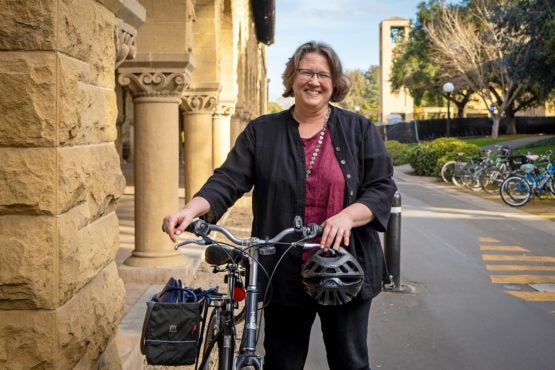Living sustainably, with a little help from My Cardinal Green
Through My Cardinal Green, everyone in the Stanford community can set conservation goals, track their progress on personal dashboards, earn points and receive rewards.
With the arrival of a new year, Stanford is inviting the campus community to dedicate – or rededicate – themselves to creating a “greener” campus by participating in My Cardinal Green, whose call to action is, “Small actions add up!”

Heather Hadlock, an associate professor of music, says participating in the My Cardinal Green program reinforces her commitment to biking to campus regularly. (Image credit: Farrin Abbott)
Through the program, faculty, staff and students can set individual conservation goals, track their progress on personal dashboards, earn points and receive rewards.
Last year, the program inspired Gina Ford, a senior administrator in the Hagey Laboratory for Pediatric Regenerative Medicine, to stock green products in the lab’s kitchen, including reusable, washable paper towels, cloth dish towels, ceramic dinnerware and sporks.
“Some colleagues now bring their own silverware to use for lunch, rather than using plasticware,” she said. “To witness that change is rewarding.”
Ford, who said she is notorious for turning off power when it’s not in use, also created a “meeting in progress” sign for the lab’s conference room. Last year, there were times when she turned off the lights, thinking the room was empty, only to hear, “Hey, I’m in here!” After flicking the lights back on, she would gently remind her colleague about the sign.
This year, Ford’s colleagues can expect to learn more ways to live sustainably, since one of her 2020 goals is, “Encourage my team to be green!”
Ford is one of 5,720 members of the university community participating in My Cardinal Green, a program of Sustainable Stanford.
After completing a short survey, participants receive customized recommendations on a variety of simple, but meaningful steps they can take to reduce their environmental footprint. The recommendations are organized by category: building management, energy, engagement, events, food, labs, living on campus, procurement, transportation, waste and water.
Many of the actions include a calculation of the environmental payoff for adopting new habits, as well as links to tools and resources that can help to complete the action. For example, “Do not purchase any items in a disposable ‘to-go’ container for the next month. Potential annual savings for individual action: 1.32 pounds of waste avoided per month.”
Some actions have significant potential savings associated with them, especially in high-impact categories such as building management or labs.
- Upgrade building lighting to LED options, with potential annual savings of 23,126 kilowatt hours per year, which translates to $3,230 in utility cost savings.
- Replace current aerators in your buildings with the lowest-flow options, with potential annual savings of 31,000 gallons of water per year, or $493 utilities savings.
- Upgrade your bio-safety cabinet to a more energy-efficient model with potential annual savings of 2,740 kilowatt hours per year, which translates to $383 in utility savings.
Members of the Stanford community will also find suggestions and inspiring stories about people living sustainably on campus by subscribing to the Sustainable Stanford Newsletter.
In her office at Braun Music Center, Heather Hadlock, an associate professor of music, is using the smart power strip – an energy conservation device – that she received last year through My Cardinal Green following a sustainability audit of her office.
Her ongoing personal goal is to reduce food waste and one-time packaging by bringing leftovers for lunch in reusable containers more regularly.
“I have a tendency to lose reusable containers, or forget them at the bottom of a backpack, or leave a lid loose so they leak,” she said. “But my goal is to get better!”
Hadlock said participating in the program reinforced her commitment to biking to campus regularly – a practice she said offers its own rewards – from saving money and avoiding the hassle of parking on campus, to enjoying the daily mood boost provided by noticing trees and birds along the way to and from campus.
Tara Smalley, the program administrator at Stanford Medicine’s Global Center for Gender Equality, outfitted the team’s new office on Page Mill Road with sustainable supplies, including reusable mugs for staff and guests, and recycled paper products and pens.
“When we moved into our new space and needed a printer, I was able to shop around for one that was energy and ink-efficient, much smaller than our previous industrial copier machine, and did double-sided printing, which cuts down on consumption,” she said.
Smalley has also set personal sustainability goals this year: using mass transit at least three days a week and encouraging at least two people in her office to join My Cardinal Green.
Stanford students comprise about half of the participants in the program. Last year, the Roble Hall complex, a four-class dorm on the west side of campus, held a sustainability competition and racked up more than 10,000 points.
“We were able to drastically reduce our environmental footprint as a dorm and had a lot of fun in the process,” said Becca Ann Nelson, a senior majoring in biology in the School of Humanities and Sciences who helped lead the competition in the residence hall.
Brian Robert Smith, a master’s student in biology, said it’s fun to see points accumulate on his personal dashboard and to see the ever-rising count of how much money Stanford has saved in operation costs through his actions.
“There’s power in the choices we make, Smith said. “If a choice becomes routine, its impacts accumulate and it feels much more doable. That is the key and that’s what My Cardinal Green does so well.”
